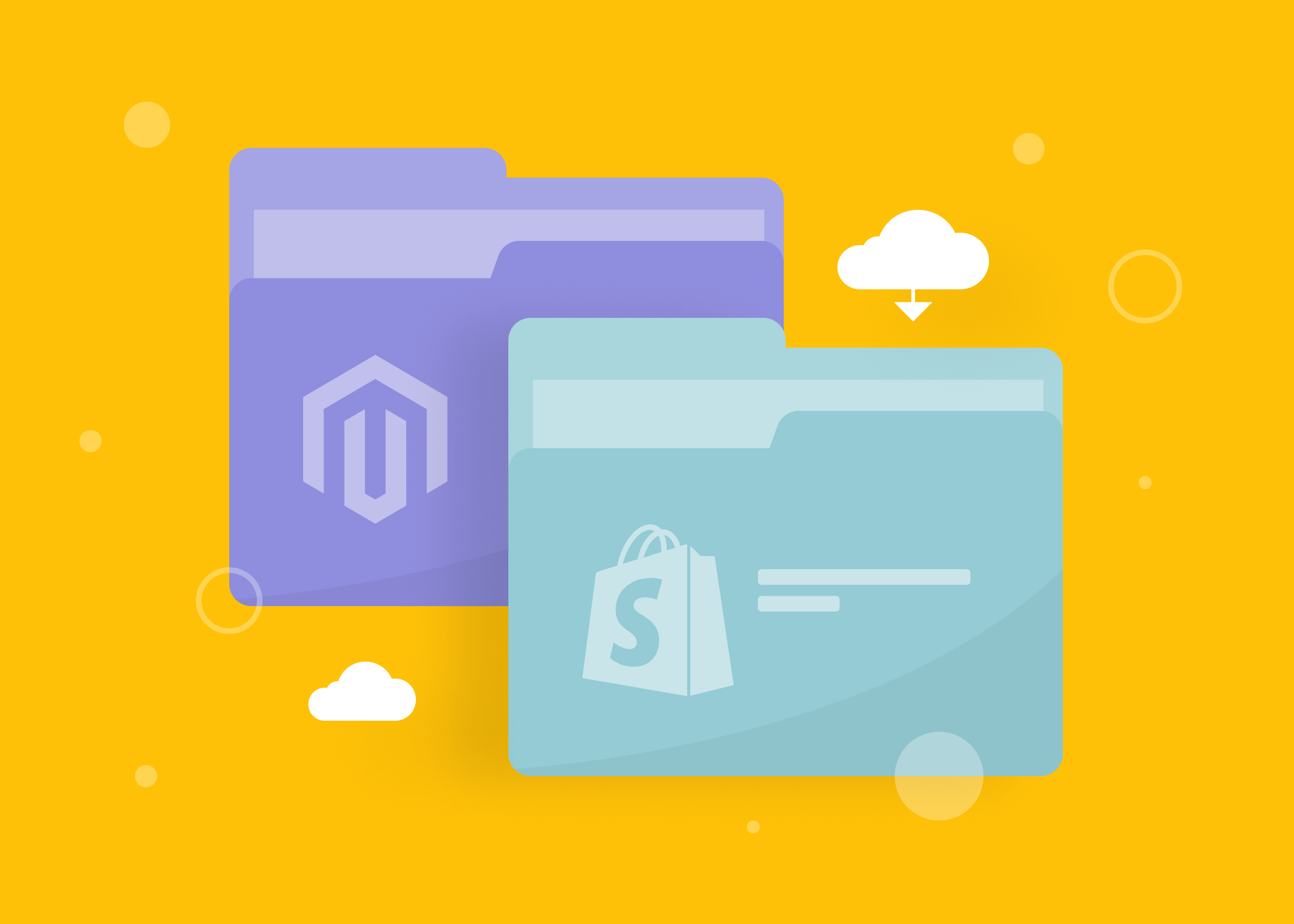Content
Why Does Your B2B Company Need an Automated Customer Loyalty Program?
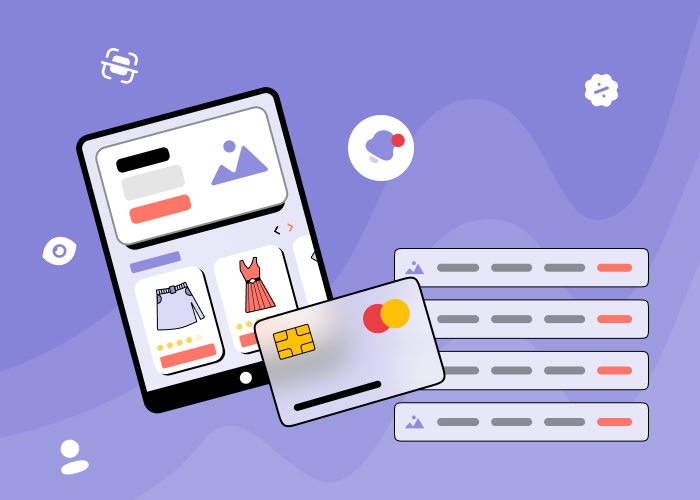
Time to read: 20 minutes
Customer loyalty programs have become a pillar of modern business. They are a basis of marketing strategy that seeks to engage new clients and prolong customer lifetime value.
Although loyalty programs are primarily part of B2C retail businesses, they are also influential in B2B operations. Much has been written about customer loyalty programs for small businesses in our blog, so this time we will focus mostly on the B2B business model.
Preconditions of B2B Loyalty Program Automation
Emerging a long time before the digital revolution swept global markets, loyalty programs are still undergoing a deep restructuring. Last year, the COVID-19 pandemic dramatically changed consumer buying habits, bringing another new loyalty into play. It is ignited by contactless engagement, which in turn is based on a digital-first experience. Online procurement has thus become a common practice among B2B clients worldwide, and the B2B e-commerce market is expected to reach $20.9 trillion by 2027.
Lets talk about itHave a project in mind?
To withstand competition, it’s important to reconsider your marketing strategy and ensure that it corresponds to the post-pandemic reality, which also necessitates that customer loyalty programs rely on digital technologies more than ever. Keep reading to learn exactly how you can benefit from launching a digitalized loyalty program for B2B customers, what templates to follow, and the best loyalty program practices to use to match your B2B market sentiment.
How Do B2C and B2B Loyalty Programs Differ?
B2B and B2C loyalty programs share common values: attracting prospects and winning customers back. Nevertheless, the specifics of the B2B and B2C markets require appropriate adjustments to the design of loyalty programs for each business model. Let’s investigate in more detail why B2B loyalty programs are distinct from B2C; this understanding will help you to plan your B2B customer loyalty strategy more precisely.
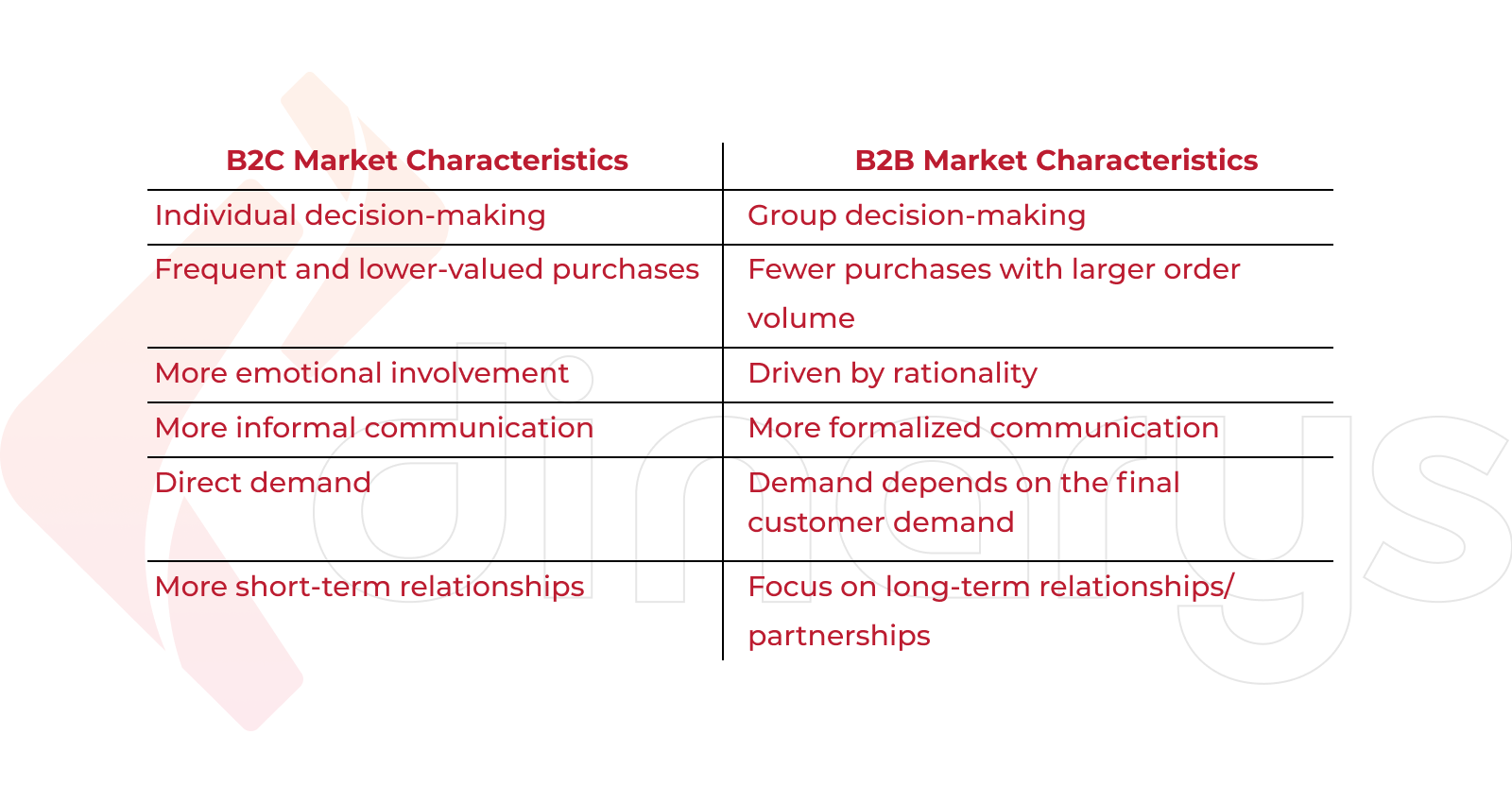
Primary target
As a rule, B2C customer loyalty schemes are designed to facilitate individual decision-making and to increase frequent and lower-value purchases. B2B relationships are built differently. A B2B company proves the relevance of its products by pursuing the interests of the entire organization with a singular focus. B2B loyalty programs inspire confidence among multiple teams, and it thus must take other measures, which we will explain later in the article.
Manner of communication
B2C communication is conducted rather informally and even entertainingly. B2C companies create customer trust by satisfying both their practical and emotional needs and by establishing strong emotional connections. Marketing techniques like hyperbolic discounting and loss aversion are therefore widely used in the B2C space.
Although the emotional component also carries weight in the B2B sphere, B2B relationships are more rational, and B2B prospects are driven by facts and numbers. Clients prioritize long-term benefits, which is unsurprising – there is no place for impulsiveness when the success of the whole business is at stake. Thus, B2B communication is more formal, and other types of leverage are applied.
Program inclusiveness
Most B2C loyalty programs are inclusive. Usually, anyone can join with ease just by leaving personal contact information, and this participation requires no additional expense.
Wholesale companies may have certain restrictions regarding the accessibility of their loyalty programs, following the attitude “less is more” or, in other words, “quality wins over quantity”. This means that they focus their efforts on the acquisition and retention of a more specialized audience, which allows them to completely fulfill their targets and derive higher ROI from smaller client databases. The bilateral benefit here is that a B2B business can target a narrow ICP (ideal customer profile), leading to early revenue, while clients are approached personally and receive premium rewards. Such selective policies also explain why paid loyalty programs are more natural for B2B.
B2B Challenges Addressed by Loyalty Programs
Let’s define the main market challenges that an average B2B company regularly faces and how to meet them via loyalty programs.
Building a customer profile
To succeed with your marketing strategy, it’s important to identify an ideal customer and ensure that their needs are met by your solutions – knocking on the right doors helps you to save time and money that would be wasted trying to sell flowers to a hay fever sufferer. To create a comprehensive ICP, one must find channels to collect customer data, and a loyalty program for B2B customers could be one of them.
Gathering feedback from your existing clients and asking newcomers their opinions on a given problem is common in loyalty programs. You can thus capture information like clients’ locations, interests, and pain points and then interpret this and respond with a corresponding offer and relevant rewards.
Customer retention vs customer acquisition
Digital marketers often raise the question of whether customer retention or customer acquisition are more cost-efficient for businesses. In our expert opinion, this question has already been answered: customer retention matters more in terms of cost-efficiency.
Since Dinarys is an e-commerce development company that provides services for the wholesale sector, we are used to operating with facts and numbers. According to a recent Invesp survey, regular customers are worth ten times more than the value of their first purchase, and the Bond loyalty report says that 78% of buyers are more likely to make another purchase from a brand that has a loyalty scheme. This leads to the conclusion that loyalty is gold, and B2B businesses should therefore emphasize customer retention strategies, in which loyalty programs remain crucial.
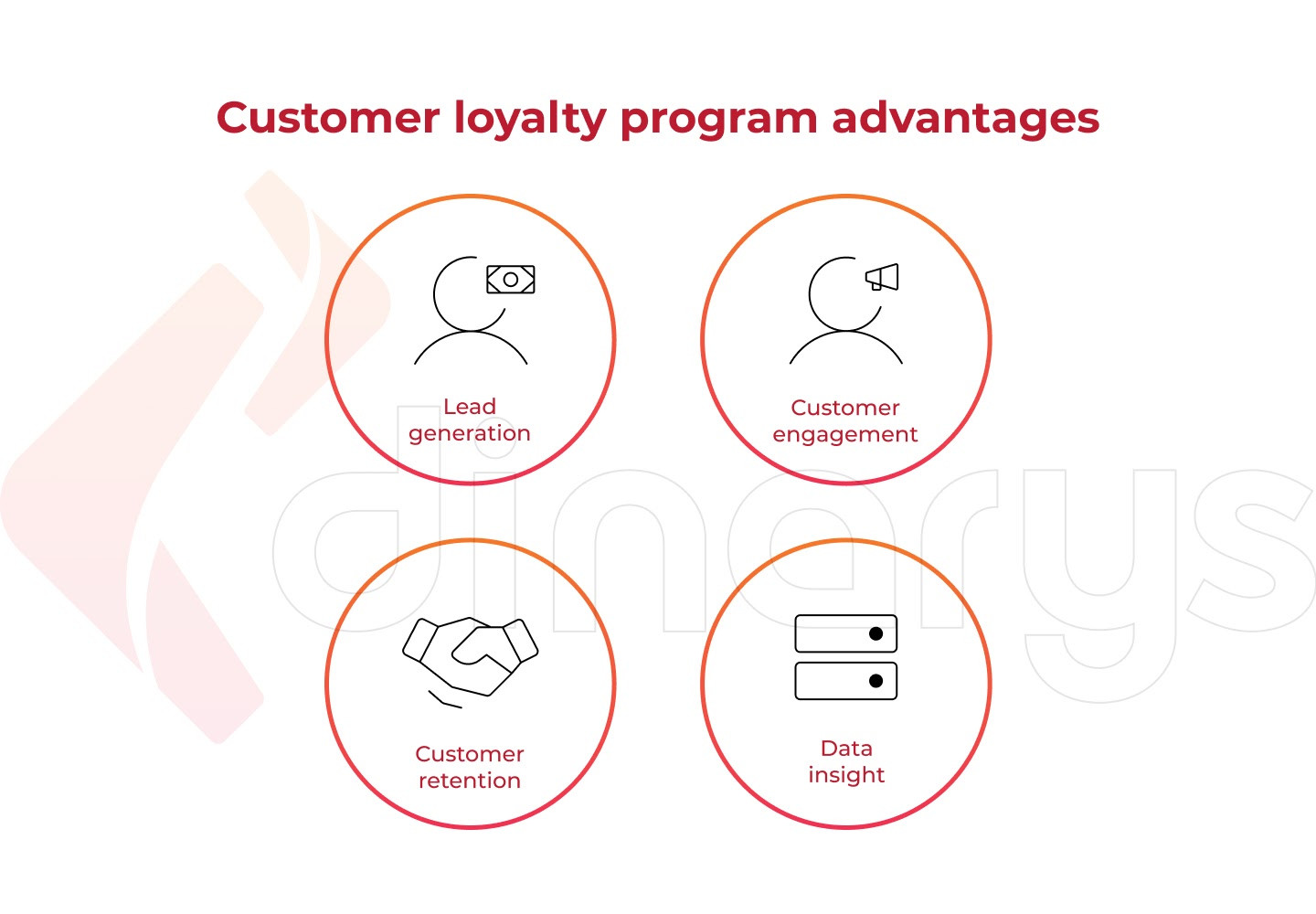
B2B lead generation
Despite customer retention being vital for business growth, B2B companies shouldn’t neglect lead generation and customer acquisition, which allow businesses to grow both qualitatively and quantitatively and to build a solid foundation for the next stage of the sales funnel – customer retention. Using B2B loyalty programs, marketers can positively contribute to optimizing lead generation. To access incentives like first purchase discounts, welcome bonuses, or educational materials, newcomers should fill in a form and leave an email address. Thus brands can gather both basic information about their leads and a subsequent reason to market to them.
How to Grow B2B Customer Loyalty?
There are multiple ways to realize B2B customer loyalty programs. Although there is no “one size fits all” framework, the following are the most widespread types of B2B loyalty programs.
Tiered incentives
This type of B2B reward system divides customers into levels or tiers of loyalty according to concrete achievements. In B2B, these achievements are usually measured by deal volume. The higher the tier is, the bigger the benefits.
The uniqueness lies behind the idea of tiered incentives; customers like to be special. Exclusive rewards and the availability of VIP status can inspire B2B clients to cooperate further with a company. For example, if a client buys 1,000 items, they become eligible for a 5% discount, receiving the impetus for purchasing larger quantities next time. Tiered incentives are a working method for building genuine, lasting relationships with clients and for increasing AOV as a result.
Next purchase discounts
This type of loyalty program follows the B2C template and entails businesses offering their clients discounts to be applied to the next transaction. Critically, such discounts are valid for a limited time, which motivates customers to return for more purchases quickly. Transaction-based immediate discounts trigger frequent repeat purchases and are suitable for reducing customer churn rate.
Referral programs
The most broadly used e-commerce reward system and considered the easiest to implement, referral programs have the twin advantages of lowering the cost of lead generation and retaining existing customers. A ThinkImpact survey reported that 78% of B2B referrals create viable leads. Referral programs work as an advanced form of word of mouth, but, in the B2B model, the sharing process is more formalized. Besides, to automate a referral campaign and keep control over referrals, a referral page is required
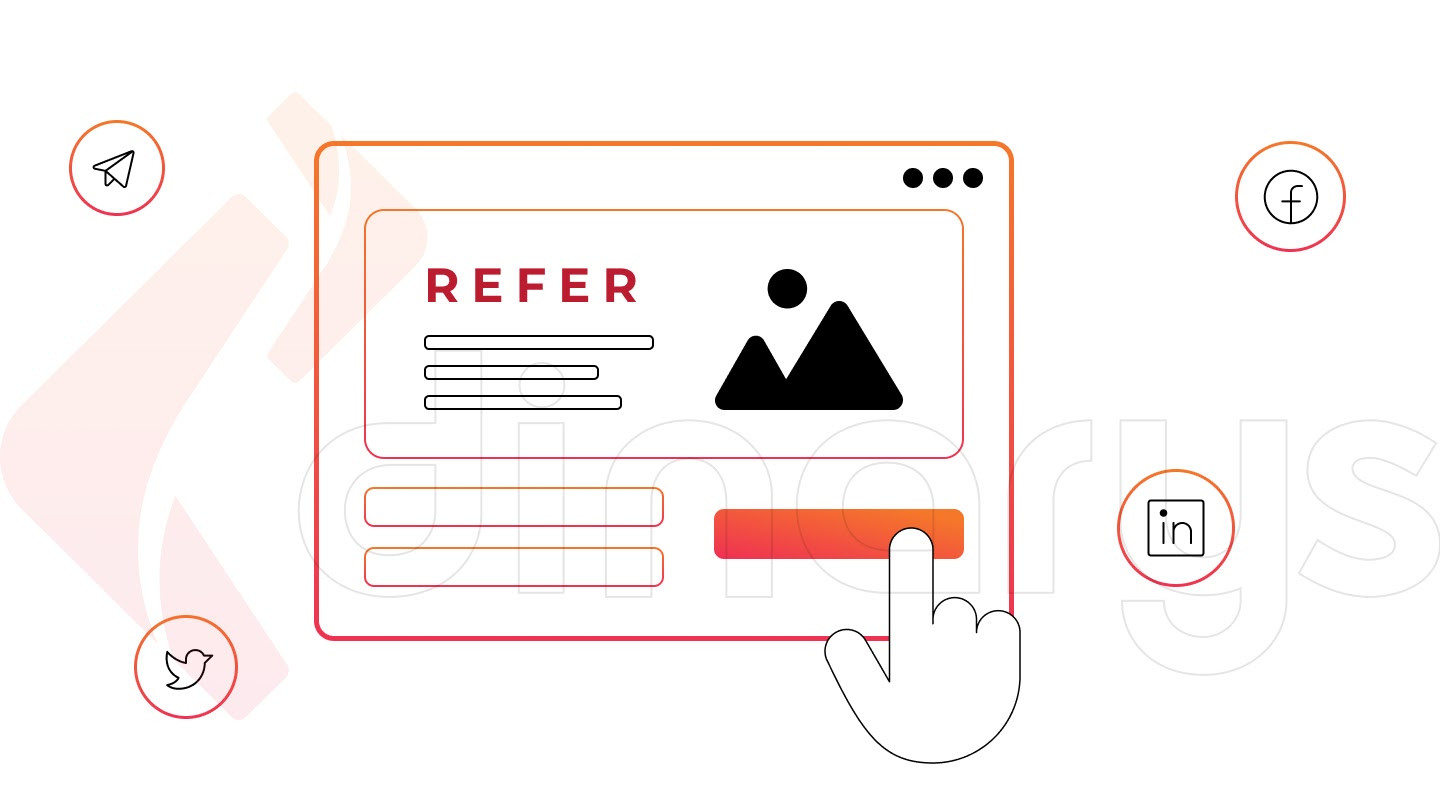
Setting up a referral program significantly improves overall B2B business performance. Given the more complex decision-making processes and greater fluctuations in demand in the B2B environment, a trusted review is important.
Loyalty programs for distributors
The need to reward your buyers is obvious, but encouraging distribution of your products could also make a significant contribution to strengthening customer loyalty. Companies that specialize in complementary products or services are a good promotional channel. By marketing directly to consumers, they can help you to expand your brand awareness and be richly rewarded in return.
How to Make the Most of Your Loyalty Program
Below are some tips and tricks to derive maximum benefit from your loyalty program for B2B customers.
Start small
Understand that a loyalty program’s final logic will require trial and error. It’s initially difficult to determine exactly what features will work best, and testing each feature separately will give individual results and a better understanding of each feature’s input.
Develop an easy-to-follow concept
The structure of your loyalty program should be well-designed and transparent, both for your customers who get involved and for your sales representatives to manage it efficiently.
Evaluate performance measures
What gets measured gets improved, and the first step toward perfection is to decide what indicators to track. B2B companies measure success in different ways, but the following are key performance indicators of B2B loyalty marketing:
- Repeat customer rate (RCR): This metric shows how many customers made at least two purchases from your store within a certain time frame. To calculate RCR, use this formula: RCR = Number of customers who have purchased before ÷ Total number of customers x 100. For example, if you have 5,000 customers of whom 500 return, your RCR is 10%.
- Customer lifetime value (CLV): This is the total revenue a business generates from a single customer throughout the entire relationship. CLV is an important metric to determine the cost-effectiveness of your customer acquisition strategy and to ensure the rationality of operating expenses. Read this article to learn how to calculate CLV.
- Net promoter score (NPS): This indicator ranges from -100 to 100 and measures the level of customer loyalty to a brand. Clients are asked, “How likely are you to recommend the company/product/service to your friends/colleagues?” Respondents are divided into three groups: detractors (with a score below 7), passives (7–8), and promoters (9-10). To calculate NPS, passives are not taken into account, and the formula is
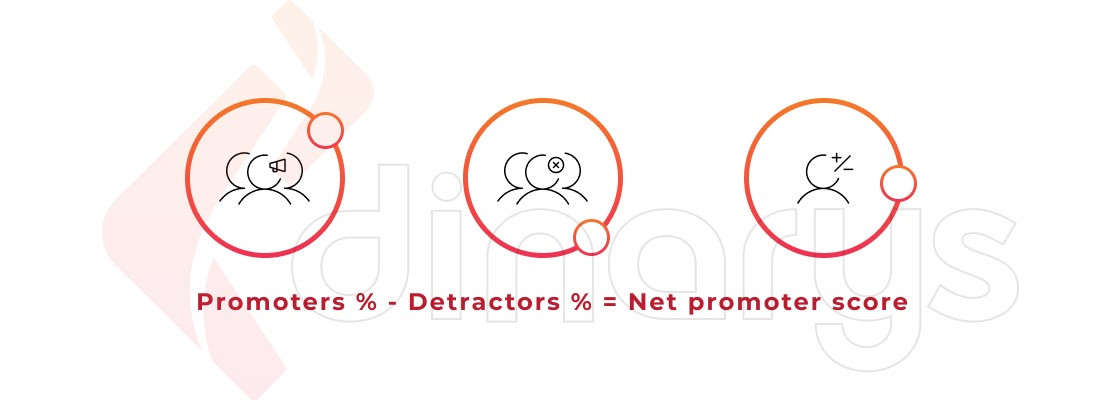
For example, if your survey resulted in 70 promoters, 10 passives, and 20 detractors, your NPS would be 50 (70% − 20% = 50). Note that, because NPS ranges from -100 to 100, it is not expressed as a percentage.
Other Ways to Get Close to Your Clients
Loyalty can be influenced by many factors. To make your B2B customer loyalty strategy more effective, make sure you have all the prerequisites for a top-notch shopping experience once your loyalty scheme is working. This will maximize the chances of repeat purchases.
Lets talk about itHave a project in mind?
Personalized shopping experience
Numerous B2B companies face the challenge of personalization and wonder how to execute it correctly, while 70% of clients claim that recognition of their needs impacts their loyalty. Nowadays, it’s possible to personalize a shopping experience with the help of customized product catalogs and price lists on a B2B website.
Also, you can improve personalization by creating targeted landing pages, and email marketing can be used to reach an audience. The market offers plenty of worthwhile marketing automation tools. For example, MailChimp comes with a built-in feature for customer incentives based on previous order history, and there are many more opportunities than we can count.
Self-service
A new “self-service” era, birthed by the effects of COVID-19, has begun. Self-service can apply to any point of sale, whether physical or digital, and clients are provided with tools and information that allow them to interact with a brand without the assistance of sales representatives.
Another good thing about having a B2B website is that it’s possible to deliver a digital self-service experience, which is widely valued among wholesalers. Website usability and accessibility are integral parts of online procurement, and by integrating self-service functions, you enable customers to investigate products, place real-time orders, and effectively resolve other issues on their own.
Chatbots are a good example of a self-service implementation. Powered by AI, they recreate human-like conversations, direct prospects to the information they need, and – as a pleasant bonus – help businesses to lower the cost of customer support.
Best B2B Loyalty Program Tools
Finally, we reach the most interesting part of the article: loyalty program implementation. As developers with top-of-the-line experience in multiple B2B industries, Dinarys delivers high-income B2B solutions that meet and exceed modern standards.
To do this, we use Magento and Shopware, which are market-leading e-commerce platforms with extensive capacities for growing sustainable B2B businesses. What’s the significance of Magento and Shopware? Let’s see.
Magento evolves with market dynamics. Its strength lies in its flexibility to adapt quickly to changing market realities. Other Magento strengths are
- Mobile-optimized websites.
- High integration capabilities.
- Numerous extensions to address business needs.
- Business intelligence tools and reports.
- Powerful APIs to unify commerce channels.
Shopware is also one of the most sought-after frameworks among B2B enterprises. Following the API-first approach, it serves as a stable working basis for complex projects. Here are some good reasons for choosing Shopware for your B2B e-commerce:
- B2B Suite to wrap all B2B processes into a single solution
- Features for seamless internationalization
- Elasticsearch to avoid getting lost in the diversity of products
- Comprehensive rights and roles management
- Customer-specific settings
Take a look at what the B2B suite is all about in this video.
How to digitalize your B2B customer loyalty program with Magento
To enhance your Magento web-store functionality with loyalty program automation, consider the following extensions:
- Tier Price for Magento 2 optimizes a tiered loyalty program with an automated tier pricing table. It allows customers to evaluate proposals more conveniently. The tiers are displayed in a tabular form that includes Quantity, Save Amount, and Price Per Item columns. The module helps to simplify decision-making and motivate B2B clients to make faster purchases.
The extension also enables shop admins to segment customers into different tier groups and apply the same tier prices to products in masse. Store admins can also group separate users to offer them exclusive pricing tiers.
- Magento 2 Loyalty Program nurtures loyalty by rewarding repeat buyers for their duration of membership, amount of spending, order volume, number of orders, and for special occasions, like birthdays and holidays.
The extension comes with a dedicated page that displays the loyalty program terms and conditions, and because it doesn’t store any customer-specific data, it’s completely GDPR compliant.
- Reward points is an all-in-one extension with which you can create compound loyalty programs that attract warm leads through various channels. By rewarding clients with extra points, you can also draw more attention to cross-selling products and promote specific goods. Besides, you can attract leads through a fully-fledged Magento referral program and offer perks to both referrers and referred. In this video, you can learn more about the opportunities Reward points bring.
The multifunctional user dashboard and built-in reports are two more reasons to consider this extension. Your clients can manage their interactions with your brand (see how many points they earn, browse their transaction history), while you can assess the number of points a specific user has earned. With the broad features of Reward Points, everyone stays on the radar.
Lets talk about itHave a project in mind?
Loyalty program tools for Shopware 6
For building your customer trust with Shopware 6, check out these tools:
- Free products is the perfect choice to reward your customers with, well, free products. With this Shopware plugin, buyers who reach a particular order amount are entitled to a reward that automatically appears in their shopping cart. Store admins can configure the automatic free product placement and set the minimum order amount needed to receive it.
- Bonus System for Shopware 6 is a fully featured extension that helps in planning your loyalty program to the last detail. You can use the free demo to determine if the module will work for you. The bonus system enables clients to collect bonus points for each order or as refunds to redeem during their next checkout. Admins can set the exchange rate (e.g., 1 point is 1 euro), exclude certain customer segments from the bonus system, customize bonus point badges, and constructively manage customers’ bonus points.
- Referral reward program is an optional module to increase conversions without extra costs. With this plugin, users receive a link with a special code to share with their relatives, friends, or business partners, who in turn receive one-time discounts on their first purchase. Once that purchase is completed, the referrer gets a discount on their next order as well. The module also allows store operators to keep track of the exact number of references and configure the reward amount.
Conclusion
B2B incentive program digitalization is a must-have in a time when global technological progress is accelerating. Loyalty program automation can address the key issues of online marketing:
- Targeting the right audience with the right message
- Generating leads
- Fostering client relationships
- Deriving insights for faster growth
If you are looking for seasoned e-commerce consultants, you’re in the right place. Knowledge and competencies gained through years of dedicated experience in B2B are fully invested in Dinarys’ development processes.
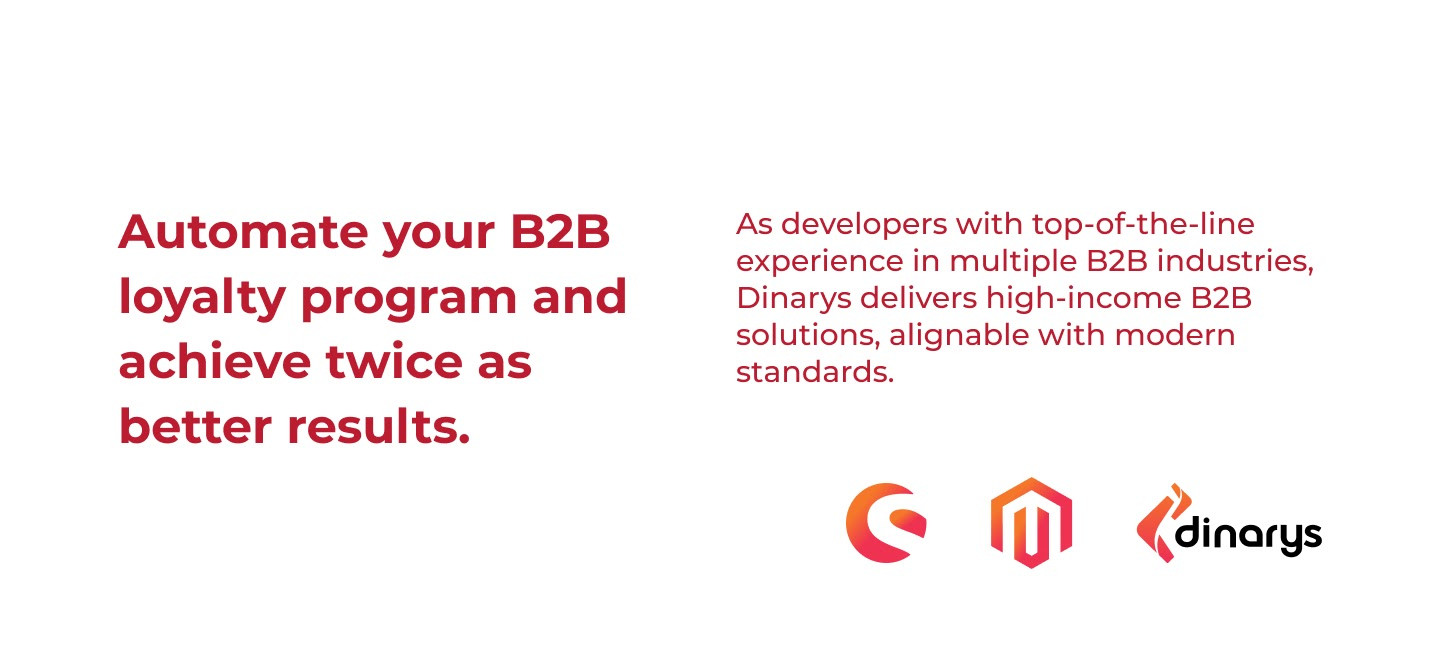
We can build an all-embracing B2B solution from scratch and guarantee its operational simplicity and short time-to-market. If you have a project that requires assistance, the Dinarys team will readily reflect your brand message through relevant custom or ready-made technologies.
Send us a request today, and we will diagnose and address all the pain points of your business.
Lassen Sie Profis Ihre Herausforderung meistern
Unsere zertifizierten Spezialisten finden die optimale Lösung für Ihr Unternehmen.




